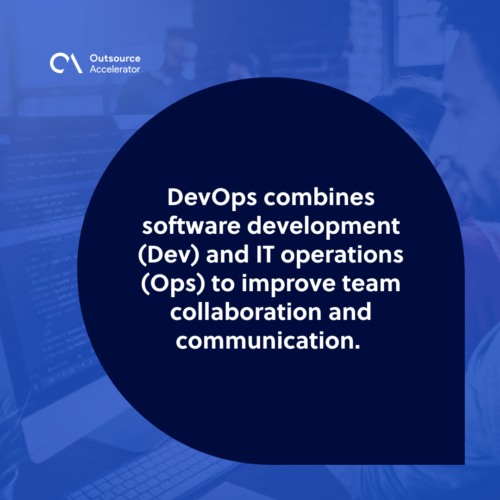DevOps vs. Agile: Which is right for you?

Today’s fast-paced business environment leaves organizations under constant pressure to innovate and deliver products and services quickly.
Many companies are turning to DevOps vs. Agile methodologies to meet these demands. While both approaches aim to improve efficiency and productivity, they differ significantly.
This article explores what DevOps and Agile are, their differences, the benefits of each approach, and how to choose the right methodology for your enterprise.
DevOps vs. Agile: Definition of terms
Before we discuss how DevOps and Agile are different, let’s define each methodology.
What is devops?
Firstly, DevOps combines software development (Dev) and IT operations (Ops) to improve team collaboration and communication.
This methodology aims to automate the software delivery process, reduce the time between code development and deployment, and improve the quality of software releases.
Some of DevOps’ key principles and practices are:
- Continuous integration and continuous delivery (CI/CD)
- Infrastructure as code (IaC)
- Automated testing
- Collaboration and communication
- Continuous monitoring and feedback

What is Agile?
The Agile methodology emphasizes flexibility, collaboration, and customer satisfaction.
It aims to deliver working software quickly and frequently, adapt to changing requirements, and continuously improve the development process.
Some of Agile’s key principles and practices include:
- Iterative and incremental development
- Cross-functional teams
- Continuous delivery
- Customer collaboration
- Agile manifesto and principles
DevOps vs. Agile: Key differences
DevOps and Agile share some similarities, but they have significant differences that are worth being noted.
Here’s how these methodologies differ:
Focus
DevOps focuses on improving collaboration and communication between development and operations teams to automate the software delivery process. All the attention is pointed to functional and non-function readiness.
On the other hand, Agile focuses on delivering working software quickly and frequently, adapting to changing requirements, and continuously improving the development process. It operates based on the operational and business side of things.
Scope
When it comes to the scope of DevOps vs. Agile, the former covers the entire software delivery process — from development to deployment and maintenance. DevOps is all about taking ready-to-release software and launching it reliably and securely.
Agile is centered mostly on the development process — from planning to delivery. After the software’s release, Agile teams won’t have anything to do with what happens to it anymore.
Tools
Regarding the tools used by DevOps vs. Agile, DevOps relies heavily on automation tools. Its tools provide key functions such as configuration management and CI/CD. Examples of popular DevOps tools include:
- Puppet
- Chef
- TeamCity
- OpenStack
- AWS
Agile plays up collaboration and communication between team members with less emphasis on specific tools. But there are still tools that especially assist Agile teams, such as:
- JIRA
- Bugzilla
- Kanboard
Culture
DevOps is mostly a culture of collaboration, communication, and continuous improvement. Its operational and development teams are separate, though they should still be in frequent communication.
The DevOps team also addresses the gap between development, testing, and operations.
Agile accentuates a culture of flexibility, adaptability, and customer satisfaction. All Agile team members should be able to perform their respective roles, increasing their understanding and accomplishment of their functions and goals.
Furthermore, Agile addresses the gap between the development and testing teams and customer needs.

Benefits of DevOps and Agile
DevOps and Agile methodologies offer significant benefits to organizations. The key advantages of each approach are:
Benefits of DevOps
- Faster time to market
- Improved collaboration and communication between teams
- Reduced errors and downtime
- Increased efficiency and productivity
- Greater agility and flexibility
Benefits of Agile
- Faster time to market
- Improved customer satisfaction
- Increased adaptability to changing requirements
- Greater transparency and visibility
- Improved quality of software releases
DevOps vs. Agile: Choosing the right methodology
Choosing the right methodology depends on several factors, such as the size and complexity of your company, the nature of your projects, and your team’s skills and expertise.
Here are some tips to help you choose between DevOps vs. Agile:
1. Identify needs
Evaluating your business needs is an important first step when choosing which methodology to adopt.
Think about what your goals are and what challenges you face. What are your team’s strengths and weaknesses, and what skills and expertise do you need?
2. Consider the projects
Next is to consider the nature of your projects. Determine whether they are large and complex, or small and simple. Do they require a high degree of collaboration and communication, or can they be completed independently?
Agile teams, although usually small, are good for handling complex projects, while DevOps is made to manage end-to-end engineering processes.

3. Assess the team’s skills
Assess your team’s skills and expertise. Do they have experience with DevOps or agile methodologies? Do they have the technical skills and knowledge required for each approach?
4. Experiment and adapt
Finally, try to experiment with different methodologies and adapt as needed. Try a hybrid approach that combines the best of DevOps and Agile, or experiment with different tools and practices to find what works best for your company.
You can also try outsourcing these methodologies so you can experiment in the capable hands of experts. Firms like Saigon Technology offer DevOps development services, while others offer agile assistance.”
DevOps and Agile methodologies offer distinct software development and delivery approaches with overlapping yet different focuses.
Choosing between DevOps vs. Agile depends on several factors, but by evaluating your firm’s current situation, you can choose the right methodology and achieve your goals.







 Independent
Independent




